The introduction of antibiotics has made many modern medical procedures possible, including cancer treatment, organ transplants and open-heart surgery. However, among other things, their misuse has resulted in the rapid rise of “antimicrobial resistance” (AMR) and some infections are now untreatable. The current health burden is already significant with more than 35,000 people dying in the EU per year due to antibiotic resistant bacteria. AMR also causes an economic burden of about 1.5 billion Euro per year in the EU. Furthermore, not enough new antibiotics are available – the clinical pipeline has dried up.
The Problem: Not Enough Investment
Due to financial risks and barriers, caused by long development times and low consumption (which is welcome with regard to combating resistances), companies are not investing enough in new antibiotic research and development. It is simply not profitable to invest in a product that is to be put on the “shelf” in case it is needed in the future. It is understandable that, generally, companies would rather invest in more economically successful medicines (e.g., for cancer or respiratory treatments).
What Europe has been Doing up to this Point
Up to now, new antibiotic research and development is supported mainly through EU and national grants to “push” innovation. However, this only has a short-term impact as it targets specific projects. These actions have not been successful enough in creating the amount of new antibiotics needed. The regulatory regime must change to ensure long-term and continuous investment in research and development.
What Europe is (planning on) Doing: “Netflix” and “Vouchers”
Currently, the most widely discussed solutions are two incentive models called the „subscription model“ – also often referred to as the “Netflix model” – and the „voucher model“.
The “Netflix model” involves the state paying (annual) fees – fully or partially decoupled from sales volumes – to a company for a certain period, in return for the guaranteed supply of an antibiotic. In this way the company receives a guaranteed income which is (somewhat) independent from the sales volume. The UK has been the first country in the world to successfully launch such a „subscription model”. It has been used for two antibiotics which will treat around 1,700 patients per year. In the EU, there is also a pilot in Sweden, which has already resulted in 3 new commercial launches. These two versions of the model (which differ slightly in the specifics of their design) mean that both countries can now access more newly marketed antibiotics than most other countries in the world.
The “voucher model” aims to reward companies, that bring a new antibiotic onto the market, by issuing them with a voucher. This voucher is a right to extend some form of legal protection to a medicinal product. It is therefore a protective measure against competition. This protection can come e.g., in the form of patent-like protection or it can cover data exclusivity, so that clinical trial data is protected against competitors. An interesting characteristic is that the voucher does not need to be applied to the new antibiotic product itself but can be used for any (economically successful) medicinal product in the company’s portfolio. Furthermore, the possibility of being able to sell the voucher to another company is under discussion, so that it becomes a tradable good with a negotiable price.
Advantages and Disadvantages of such Incentive Models
The “Netflix model” is especially beneficial to private companies and researchers, as a certain level of income is guaranteed. However, this will only be for a limited period of time. Investment in other medicines may still be more profitable, especially in the long term. For the healthcare system, the main advantage is a guaranteed supply of antibiotics, which lowers the risk of shortages. The main disadvantage of this model, however, could be with regard to its EU wide implementation: such a model requires economic and political commitment from Member States to pay the annual fees. Investing in research and development of a new cancer or Alzheimer medicine for example may be perceived as much more important and better value. It is therefore expected that few and only the richest Member States will be able to implement such an incentive model. Currently, Sweden which is one of the richer Member States, is the only EU country which is using this system as a pilot. This may create unequal access to new antibiotics between Member States.
The „voucher model“ is especially attractive to companies doing the necessary research as such a voucher can be used to protect them from competition. As a result, a company that brings a new antibiotic to the market could choose the best option for their portfolio, including a choice of applying the voucher to the new antibiotic itself or to another medicine. Additionally, the use of the voucher as a tradable good with a negotiable price may be profitable for that company. Its main advantage for Member States in comparison with the “subscription model” is that it can be implemented with little or no government funding. The disadvantage of a “voucher model” for the healthcare system is that it protects against competition. Generics can then only enter the market at a later stage, thus delaying competition and contributing to the high prices of such medicines. This can also lead to unequal access to medicines that are protected in such a way, as not all EU healthcare systems can pay for high-cost medicines.
What Europe Should Do
Both models have their advantages and disadvantages for pharmaceutical companies, researchers, Member States, the healthcare systems and patients. There is no ideal model for all stakeholders. Both the “voucher model” and the “Netflix model” will be beneficial to researching pharmaceutical companies and will enable them to invest in new antibiotic research and development. The “voucher model” on the other hand is most beneficial for Member States in terms of implementation costs. The “Netflix model” has already been piloted and has shown some success whereas the „voucher model“ has not been used yet and therefore its real impact in practice is not yet known. At first sight, an “ideal” situation for continuous innovation would be to have both systems available in all EU Member States for companies and researchers to use. That way, they could make a choice on what fits their situation best. Yet, all measures will come at some form of (economic) cost. The EU and Member States urgently need to agree on concerted action. The upcoming reform of the EU pharmaceutical legislation in March presents a window of opportunity for Europe to present its solutions to the issue.
This contribution is an abridged and revised version of the cepInput No. 2 (2023) “Antibiotics: A multi-perspective challenge”.

More about european Healthcare:
Copyright Header Picture: shutterstock/solarseven
Könnte Sie auch interessieren
10. Juli 2023
Metaverse Momentum for European Healthcare
Virtual worlds will revolutionise healthcare. By combining virtual reality with…
30. März 2023
Health Goes Europe
Research, policy making, personalised medicine, official statistics or…
4. Juli 2022
Europas Weg zur Gesundheitsunion
Alle für einen? Oder doch jeder für sich selbst? Die Corona-Pandemie hat den…


